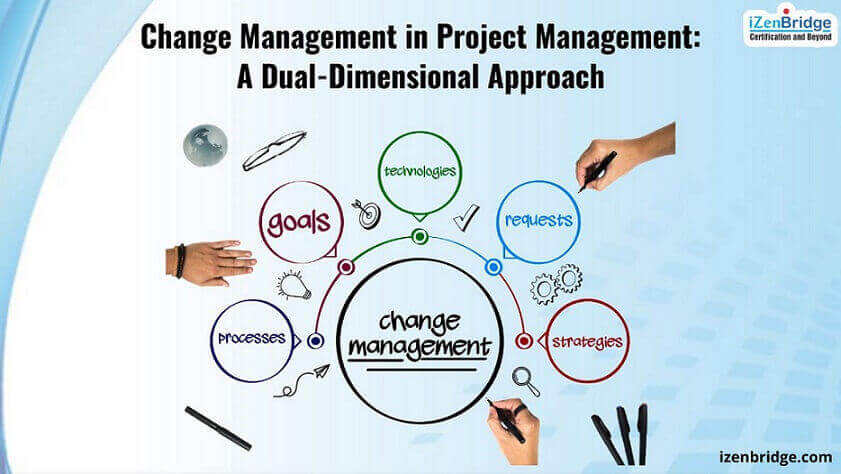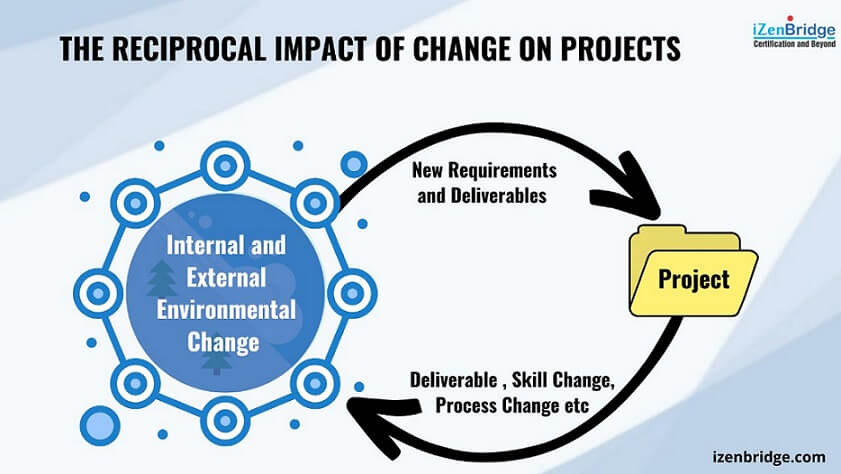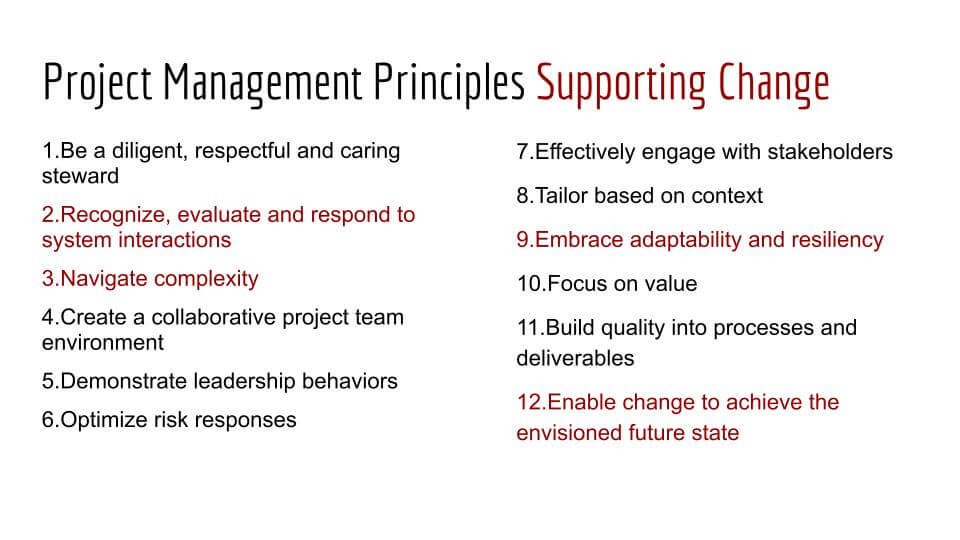

In this Article:
Change always happens in any organization, and project environments are no different. Project Managers often handle these changes. This article talks about the two-way relationship of change in the lifecycle of a project. We look at how projects can lead to changes in an organization and how changes in an organization change affect the project. This article is aligned with PMP Exam Content Outline, which details the tasks related to managing change that Project Managers need to know.
Now, let’s look at the specific tasks of a Project Manager as listed in the PMP Exam Content Outline:
Business Domain : Task 4: Support Organizational Change
– Assess Organizational Culture
– Evaluate impact of organizational change to project and determine required actions
– Evaluate impact of the project to the organization and determine required actions
A project manager’s job involves juggling two types of change. One, they must adapt to changes that are happening within their organization. Two, they also need to bring about new changes within their organization through their project work. This means they must understand their project’s larger role within the organization, predict its possible effects, and know how to handle those effects successfully.

Adapting to Organizational Changes
Organizational changes can take many forms. These can include a shift in leadership, a new business focus, an alteration in stakeholder composition, the implementation of new processes, or even new compliance requirements. Such changes can have profound effects on how a project is executed.
For project managers, the ability to adapt to these changes is paramount. This means not just reacting to change as it happens, but also anticipating potential changes and preparing the project to respond effectively. This is a proactive skill that requires project managers to have their fingers on the pulse of the organization and to be constantly aware of evolving trends and changes in strategy.
Facilitating Change within the Organization
Projects, by their very nature, bring about change. They create something new that didn’t exist before – whether that’s a product, a business model, an automated process, or even new skills amongst the project team members. These ‘deliverables’ then have to be implemented within the organization, which often necessitates changes in the organization’s operations or procedures.
Consider a project with an internal deliverable, such as automating a process within the organization. Once the project is completed, the automation tool will need to be implemented. This could require training for staff, modifications to daily operations, or changes to reporting structures. In such a case, the project manager may have a role in facilitating these changes, ensuring the deliverable is understood, and helping to realize the benefits of the project.
In contrast, if a project’s deliverable is for an external customer, the project manager may have less visibility of the changes triggered by their project. But it’s important to remember that even in these cases, changes will still occur. The organization might develop new skills, accumulate historical data, or even change its approach to similar projects in the future.

Change is a fundamental element in the fabric of any organization. As such, it’s no surprise that most project management principles (as defined in PMBOK® Guide Seventh Edition) involve change to some degree. Four principles, however, stand out due to their significant implications for project leaders and managers.
#2.Recognize, evaluate and respond to system interactions
Principle 2 highlights the need to recognize, evaluate, and respond to system interactions. This essentially implies that as a project manager, you should be alert to any changes in operational growth, program, and portfolio groups. They may interact with you differently, prompting a need for response and potential adaptations. In this context, systems could range from business units to customer support groups. If their behavior changes, it’s your responsibility to adjust accordingly to maintain alignment with the desired outcome.
3.Navigate complexity
Navigating complexity is another crucial aspect. This principle acknowledges that things won’t always be clear from the onset. As you progress, you’ll gain more insights, understand what works and what doesn’t, and adapt your approach accordingly. This continuous process of learning and adapting is key to helping organizations achieve their objectives. An essential role of any project is to drive change. This essentially means that projects are expected to produce unique deliverables. Consuming these deliverables necessitates change within the organization. For instance, if a project is initiated to automate a process, upon its completion, employees will need to adapt their behavior to use this automation effectively.
9.Embrace adaptability and resiliency
Further emphasizing the importance of adaptability and resilience, another principle explicitly mentions these qualities. Having the flexibility to adjust to new situations and the resilience to bounce back from setbacks is vital in managing change effectively.
12.Enable change to achieve the envisioned future state
Lastly, the principle about enabling change to achieve an envisioned future state reaffirms the central role projects play in driving organizational change. Projects are launched with the intention of enabling the organization to reach new business heights or penetrate new customer segments. This means, as a project manager, you are not just delivering a product or service, but also enabling change.
These project management principles, while defined at a high level, are crucial for managing change effectively. They provide guidelines on how to react and adapt to various situations and challenges that come your way, thereby ensuring the successful delivery of value to your customers.
In the dynamic world of project management, the ability to adapt to organizational changes is a crucial skill. What this means is that as a project manager, you need to first identify the change and then respond to it effectively. You might notice that things are not the same as when you started, and that these changes might be impacting your project outcomes. So how do you recognize this change, and more importantly, what should you do next?
Recognizing Organizational Changes
Project managers use different methods to identify changes in their organization. Here are some of them:
Responding to Organizational Changes
Once you’ve recognized a change, the next step is to respond appropriately. Here’s how:
To navigate the constantly changing landscape of project management successfully, recognizing and responding to organizational changes promptly and effectively is key. By following these guidelines, you can ensure that your project remains on track and adaptable, regardless of the changes that may come your way.
In the rapidly evolving landscape of project management, it’s critical to recognize that projects are catalysts for change. As project managers, we need to ensure that this change is not just planned but also successfully implemented. Reflecting on my early years in project management, during the rise of enterprise resource planning projects around 2000 to 2010, there was a recurring theme. Many enterprise-level software developments were failing, primarily due to inadequate change management. It wasn’t the absence of the right deliverables that was causing the failure, but rather the lack of people’s buy-in and poor change management.
The situation often played out like this: organizations would purchase a product but neglect to adequately educate their staff on its use. Consequently, employees would revert to their manual processes, ultimately leading to the abandonment of the new product. This would then be deemed a failed implementation because of poor configuration. Thus, numerous projects were failing, not due to lack of deliverables, but due to inadequate change management.
Focusing on Outcomes
The focus of project management has significantly shifted over the past few years. The focus is now on generating outcomes, not just producing outputs. It’s essential to establish mechanisms within our projects to enable organizations to adapt to these changes effectively.
Evaluating and Enabling Change
To facilitate successful change, project managers need to evaluate and enable. We must evaluate the impact of our project on people, processes, and systems and assess the various elements of our organizational environment or culture. Based on this evaluation, we then need to develop a strategy that allows the organization to adapt to the new deliverable.
Driving the Change
As a project manager, there are specific tasks you should undertake to enable the organization to adapt to change. These include:
The role of a project manager extends beyond planning and executing. You may need to support setting up a help desk, provide training, mentoring, and be part of a larger team working towards the successful implementation of change. The ability to drive change effectively is a crucial competency for today’s project managers. With these strategies in place, you can ensure that your projects deliver not just outputs, but also meaningful outcomes that align with the strategic goals of your organization.
In conclusion, change and project management are inherently intertwined. As Project Managers, we not only steer the helm of our individual projects, but we also act as catalysts for meaningful, strategic change within our organizations. This necessitates a deep understanding of our organizations and the agility to navigate and drive change effectively. It also underscores the importance of mastering the art of change management – an essential skill in today’s dynamic business environment.
Our projects are not confined to deliverables; they have far-reaching implications on the processes, culture, and overall trajectory of our organizations. Hence, the role of a Project Manager extends beyond project completion and often involves facilitating the organization’s adaptation to the changes ushered in by the project.
To equip yourself with the necessary tools to excel in this role and make a lasting impact on your organization, we highly recommend enrolling in our PMP Live Session. Aligned with the PMP Exam Content Outline, this course is designed to provide a comprehensive understanding of managing change in the dynamic field of project management. We look forward to welcoming you to this transformative learning experience.
| Name | Date | Place | – |
| PMP Certification and Training | 13 – 26 April 2025 | Bangalore | More Details |
| PMP Certification and Training | 10 May – 1 June 2025 | Chennai | More Details |